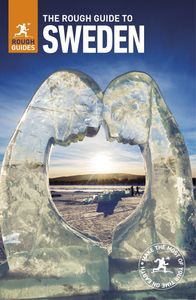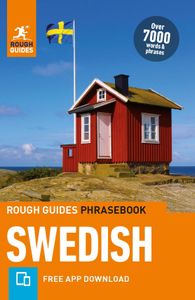The Glass Kingdom
Glass-making in Sweden was pioneered by King Gustav Vasa, who’d been impressed by the glass he saw on a trip to Italy in the mid-sixteenth century. He initially set up a glassworks in Stockholm; however, it was Småland’s forests that could provide the vast amounts of fuel needed to feed the furnaces, and so a glass factory was set up in the province in 1742. Called Kosta, after its founders, Anders Koskull, Georg Bogislaus and Stael von Holstein, it is still the largest glassworks in Småland today.
All of the dozen or so glassworks still in operation in Småland give captivating glass-blowing demonstrations. Several have permanent exhibitions of either contemporary glasswork or pieces from their history, and all have a shop. Bus services to the glassworks, or to points within easy walking distance of them, are extremely limited, and without your own transport it is almost impossible to see more than a couple in a day (though this will satisfy most people).
The Glassriket Pass gives free entry to the glassworks and discounts on some glassware products; it’s available at the tourist office in Växjö and online (100kr; wglasriket.se).
Kosta Boda glassworks
While each glassworks has its individual design characteristics, Kosta Boda is the easiest to reach from Växjö, has extensive displays and gives the best picture of what’s available. The Kosta Boda and Åfors glassworks are both operated by the same team. While two of Kosta’s most celebrated and hyped designers, Bertil Vallien and Ulrica Hydman-Vallien, have their studios at Åfors, the bigger glassworks is at Kosta.
The outlet store here contains some of the most delicate fin-de-siècle glassware, designed by Karl Lindeberg; for contemporary simplicity, Anna Ehrner’s bowls and vases are the most elegant. Among the most brilliantly innovative works are those by Göran Wärff – examples of his expressive work can also be found in Växjö’s cathedral. Current design trends tend more towards colourful and rather graceless high kitsch; nonetheless, new designer sculptural pieces can go for astoundingly high prices: commercialized designs start at 2500kr, although for a single, traditional akvavit glass you’re looking at paying something like 200kr.
Glass-making and -buying in the Glass Kingdom
The glass-making process can be mesmerizing to watch, with a glass plug being fished out of a shimmering, molten lake (at 1200°C) and then turned and blown into a graphite or steel mould. With wine glasses, a foot is added during the few seconds when the temperature is just right – if the glass is too hot, the would-be stem will slide off or sink right through; if too cold, it won’t stick. The piece is then annealed – heated and then slowly cooled – for several hours. It all looks deceptively simple and mistakes are rare, but it nevertheless takes years to become a servitör (glass-maker’s assistant), working up through the ranks of stem-maker and bowl-gatherer.
Glassware is marketed with a vengeance in Småland – take a look at the often absurd hyperbole in the widely available Kingdom of Crystal magazine. If you want to buy glassware, don’t feel compelled to snap up the first things you see: the same designs appear at most of the glassworks, testimony to the fact that the biggest factories by far, Kosta Boda and Orrefors, are now under the same umbrella ownership, while many of the smaller works have also been swallowed up, even though they retain their own names.
IKEA
Among Swedish exports, only Volvo and ABBA spring to mind as readily as the furniture store IKEA, the letters standing for the name of its founder – Ingvar Kamprad (born 1926) – and his birthplace, Elmaryd, a farm in the Småland parish of Agunnaryd. Outside Sweden, the identity of IKEA’s originator, now one of the world’s richest men, is played down, and the firm is known for simple, modern design lines and prices that appeal to a mass market. Every item of furniture IKEA produces is assigned a fictional or real Swedish name; the styles of certain items are drawn from particular areas of the country, and are given a relevant name.
Founded in 1943 at Älmhult, a small town 50km southwest of Växjö, as a mail-order company, IKEA began producing furniture based on folk designs, which Kamprad had simplified. In the 1950s, Sweden’s existing furniture-makers were sufficiently irritated by what they regarded as an upstart that they tried to pressure IKEA’s suppliers into boycotting the company. Kamprad responded by importing furniture from abroad.
In his 1976 book, Testament of a Furniture Dealer, Kamprad wrote that from the outset, he wanted to promote “constructive fantasies”: to change the world’s view of design, rather than produce what people already believed they wanted. Having opened in Denmark in 1969, the company began expanding around the world, though it didn’t enter the US market until 1985 or the UK until 1987. In 2006, IKEA opened its most northerly store in the world in Swedish Haparanda, drawing shoppers from across Lapland.
A number of biographies have been published on Kamprad, one of which (The History of IKEA) was authorized. They have revealed Kamprad’s Nazi sympathies during World War II; in response, he blamed his former political leanings on the folly of youth.
Today, if you pass through Älmhult, you can see the original IKEA store, built in 1958; the street on which it stands is called, appropriately enough, Ikeagatan. Ironically, IKEA’s headquarters are no longer in Sweden, but in Leiden in the Netherlands.
Växjö and around
Founded by St Sigfrid in the eleventh century, VÄXJÖ (approximately pronounced “veck-shur”), 120km from Kalmar deep in the heart of Småland, is by far the handiest base hereabouts. Though its centre is fairly bland and quiet, Växjö, whose name derives from väg sjö, or “way to the lake”, is within easy reach of some beautifully tranquil lake scenery. The town itself offers a couple of great museums, and once a year comes to life for the Karl Oskar-dagar (second weekend in Aug) – a long weekend of unbridled revelry in honour of the character Karl-Oskar, created by author Wilhem Moberg, who symbolized the struggles of Småland’s Swedish peasants in the nineteenth century. In reality, it means Våxjö’s youth drink themselves silly through the nights while daytime entertainment fills the streets.
Smålands Museum
The best place to kick off your exploration of Växjö is the Smålands Museum, behind the train station, which holds two permanent exhibitions: a history of Småland during the nineteenth and twentieth centuries, with a section dedicated to Växjö, and the infinitely more interesting “Six Centuries of Swedish Glass”. The latter shows sixteenth-century place settings, eighteenth- and nineteenth-century etched glass and stylish Art Nouveau-inspired pieces, with subtle floral motifs. “Trees in Fog”, designed in the 1950s by Kosta designer Vicke Lindstrand, illustrates just how derivative so much of the twentieth-century work actually is. Look out, in particular, for the Absolut vodka bottles made in nearby Limmared, which formed the basis of today’s design.
Utvandrarnas Hus
In a plain building directly in front of the Smålands Museum, the inspired Utvandrarnas Hus explores the intense hardship faced by the Småland peasant population in the mid-nineteenth century and their ensuing emigration; between 1850 and 1929, one quarter of Småland’s population left to begin a new life in America.
The displays
The museum’s displays, which include English-language translations and audio narratives, trace the lives of individual emigrants and recount the story of the industry that grew up around emigration fever. Most boats used by the emigrants left from Gothenburg and, until 1915, were British-operated sailings to Hull, from where passengers crossed the Pennines to Liverpool by train to board the transatlantic ships; conditions on board the ships were usually dire and the emigrants often shared their accommodation with oxen, pigs, calves and sheep. Exhibitions change frequently but there’s generally a mock-up of a street in early 1900s Chicago, a popular destination for the emigrants, where all the stores are run by Swedes – everything from a grocer’s to a photographer’s shop.
Wilhelm Moberg
There’s also a section on women emigrants, entitled “Not Just Kristina”, a reference to a fictitious character in The Emigrants, a trilogy by one of Sweden’s most celebrated writers, Wilhelm Moberg. Upon publication, it became the most-read Swedish history book in the country, and was made into a film starring Max von Sydow and Liv Ullman. On display here is Moberg’s writing cabin, which was given to the museum after his death in 1973. Moberg would himself have emigrated, only his father sold a farrow of piglets to pay for his son to go to college in Sweden.
Research Centre
The museum’s Research Centre charges remarkably good rates to help interested parties trace their family roots using passenger lists from ten harbours, microfilmed church records from all Swedish parishes and the archives of Swedish community associations abroad. If you want to use the centre’s extensive information services during its peak season (May–Aug), it’s especially worth booking ahead for an appointment with one of the staff.
Domkyrkan
In the centre of town, the distinctive Domkyrkan, with its unusual twin green towers and apricot-pink facade, is certainly worth a look. The combined impact of regular restorations, the most recent in 1995, together with a catalogue of disasters, such as sixteenth-century fires and a 1775 lightning strike, have left little of note except an organ. There are, however, some brilliant glass ornaments by two of the best-known contemporary Glass Kingdom designers: Göran Wärff’s wacky church font of blue glass, a stunning triptych altarpiece made entirely of glass designed by Bertil Vallien and the tree of life with Adam and Eve surrounded by glass leaves by Erik Höglund. The cathedral is set in Linnéparken, named after Carl von Linné, who was educated at the handsome school next door.




















